As many visitors to Morocco pay Meknes, supposedly the country’s Versailles, just a short visit on a day trip – or even skip it altogether – the charming city is much more serene and authentic than her big sisters Fez, Marrakech, and Rabat.
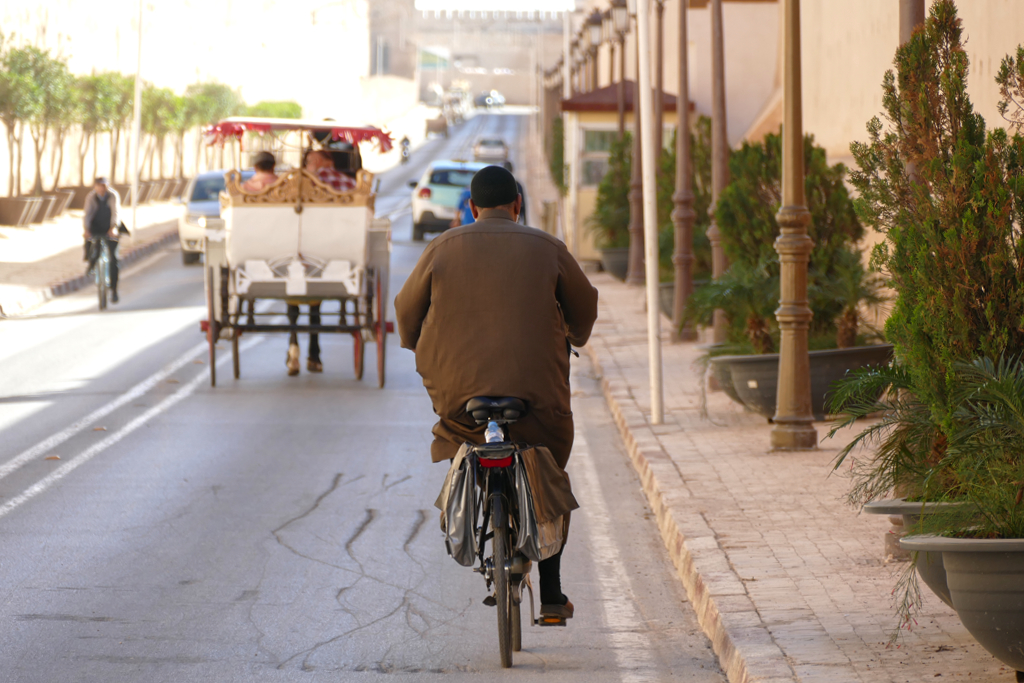
Conveniently located between Rabat and Fez, Meknes is a perfect retreat for those who need a break from the hustle’n’bustle and still want a truly Moroccan experience. Ideally, you should spend not only a day, but at least one night in Meknes to truly enjoy its laid-back oriental vibe.
Sorry, We’re Closed
I’m on the train to Meknes, full of anticipation since I’m expecting this last stop of my tour to the four imperial cities of Morocco to be some kind of grand finale.
“Is this Meknes?”, I ask the young man who’s about to get off the train. “This is the Al Amir Abdul Kader station. If you’re going to the old town, this is your stop. From here, you take a shared taxi for 3.5 Dirhams”. He answered questions never asked, however, all this is very helpful, and I thank him as I get off at this station just like him.
Obviously, I ended up paying 10 Dirhams for a small cab that I still have to share with two Moroccan ladies. But 10 Dirham is one €uro and I’m certainly not willing to get in a bad mood over the price difference of 65 cents.
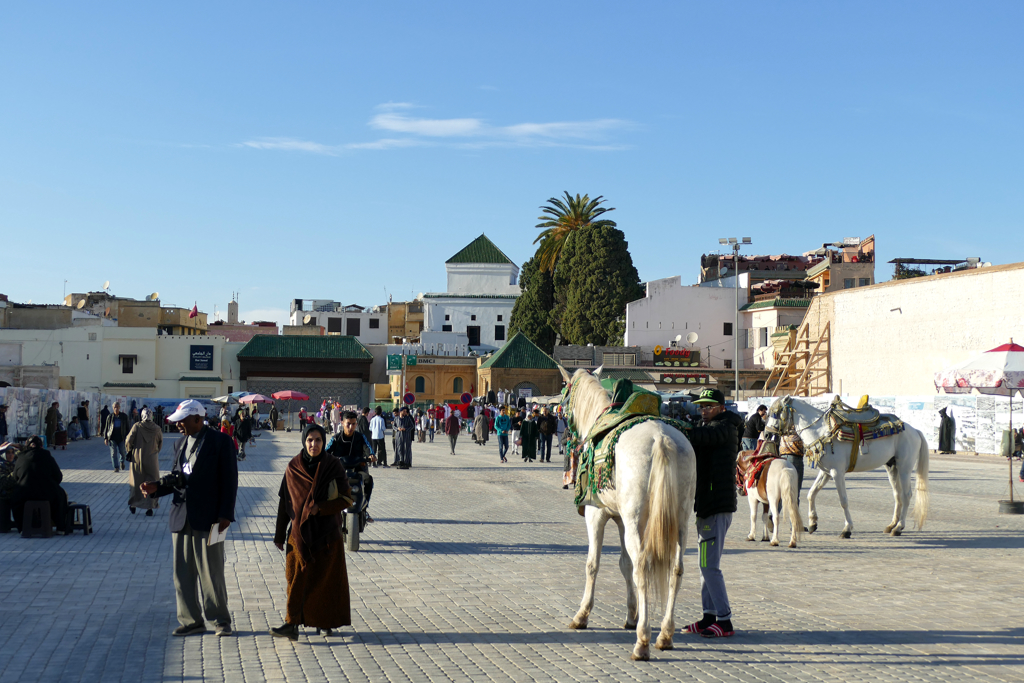
The cab driver takes me to the Place El Hadim, Meknes’ most important square. To me, it doesn’t look so very important. There are some stands, two guys with horses, and a snake charmer and it looks like a very, very sad copy of the Jemaa Al Fna in Marrakech. But I’m not here for snake charmers, anyway. I’m here for the glorious past.
Gems – Hidden Behind Tarpaulins
And really, as I turn around, I look at the Bab Mansour, supposedly Morocco’s most beautiful gate. Yet, the version I see is just printed on a huge tarpaulin that covers the real thing. Also, it’s not a very good picture. It was blurry and already a bit faded. Big billboards were proudly announcing that major construction works were going on.
So yes, that was a bit disappointing, but since that’s not the only landmark Meknes has in store, I just shrug and decide to pay the famous ancient horse stables a visit. As I get there after a twenty minutes walk, they too, are closed for renovation. Also, the famous picturesque basin behind the stables is drained and looks like a 150 times 320 meters wide construction site, and it will stay dry for a while.
Man, Meknes doesn’t make it easy for me.

Later, I learn that they are also renovating the famous Medersa Bou Inania, and in basically every street I walk in Meknes, there is serious construction work going on.
That’s nice and probably necessary since, for instance, the minaret of the Bab Berdieyinne Mosque collapsed in 2010 due to heavy rain. It killed 41 worshipers and injured 75. Hence, yes, repair and remodel as much as you like and as much as it’s needed.
But do you really have to do it while I’m in town?
Touring Meknes
What’s actually impressive is the fact that after the first sensation of disappointment, I still managed to feel the magic of Meknes between the heavy machinery and the layers of rubble and dust everywhere. While I didn’t get to see all there is to admire, I still saw a couple of landmarks that pretty much blew me away.

So after I have told you about all the wonderful things I did not get to see, here are Meknes’ glories I did visit – and these alone made the two days worth my while.
Can a Female Traveller Visit Morocco by Herself?
After my recent trip, I can say without any hesitation: Yes!
Nevertheless, I don’t know how it is once you get to the hinterland, though. But walking the streets of larger cities is definitely no problem.
However, it’s a Man’s Man’s Man’s World, and women claim far less space – in each and every sense. For instance, it’s annoying that Moroccan men tend to sit with their legs wide spread, occupying also part of the seat next to them which forces women to make themselves small – also in each and every sense.
Then, there are many tea houses that are frequented exclusively by men. As a woman, you cannot just barge in and get a refreshment. I don’t even think that you’d get openly abused there, but you would most definitely feel very much out of place.
Mostly, these men-only places aren’t exactly cozy, anyway. There are many truly lovely tea rooms where you can enjoy refreshments also as a woman, hence, why bother? For instance, many museums and galleries have amazing rooftop cafés where you get a complimentary panoramic view with your drink.
So yes, you definitely will notice cultural differences but they probably won’t impair your stay. I personally strongly disagree with this gender hierarchy, however, I was a guest in Morocco and not some missionary on a quest for gender equality.
As a female solo traveller, you won’t be able to avoid attention from men. It mostly lies in your own hands how far this gets. I’d recommend you dress modestly by covering your shoulders, cleavage, and knees. Wearing a headscarf is not necessary. Also, I need to point out that I’m not the blond Barbie type. I’m an average mature woman, and I believe that sheltered me from unwanted advances.
Therefore, I was totally bewildered when a young guy catcalled me. With great indignation, I yelled at him that I could be his mother; which left him bewildered. This happened twice, and both times in Meknes.
At the end of the day, it depends on your personality and the way you handle situations. For instance, I was often greeted by random men on the street. If it was in a non-lewd manner, I answered in a friendly way and kept walking. But if in a situation like this, you decide that you don’t want to answer, I think that’s fine. As a female solo traveller, you should do everything to feel comfortable and on top of your game
How Meknes Became the Versailles of Morocco
First things first, and that’s how the small sleepy town of Meknes became the proverbial Versailles of Morocco.
In the 11th century, the Almoravids, an imperial Berber Muslim dynasty, established an empire that extended over the western Maghreb and Al Andalus, today’s Andalusian part of Spain. In the 11th century, they built a fortress in Meknes to protect the city against the conquest by the Almohad, followers of a strict reform movement. Finally, the latter took over in 1147.
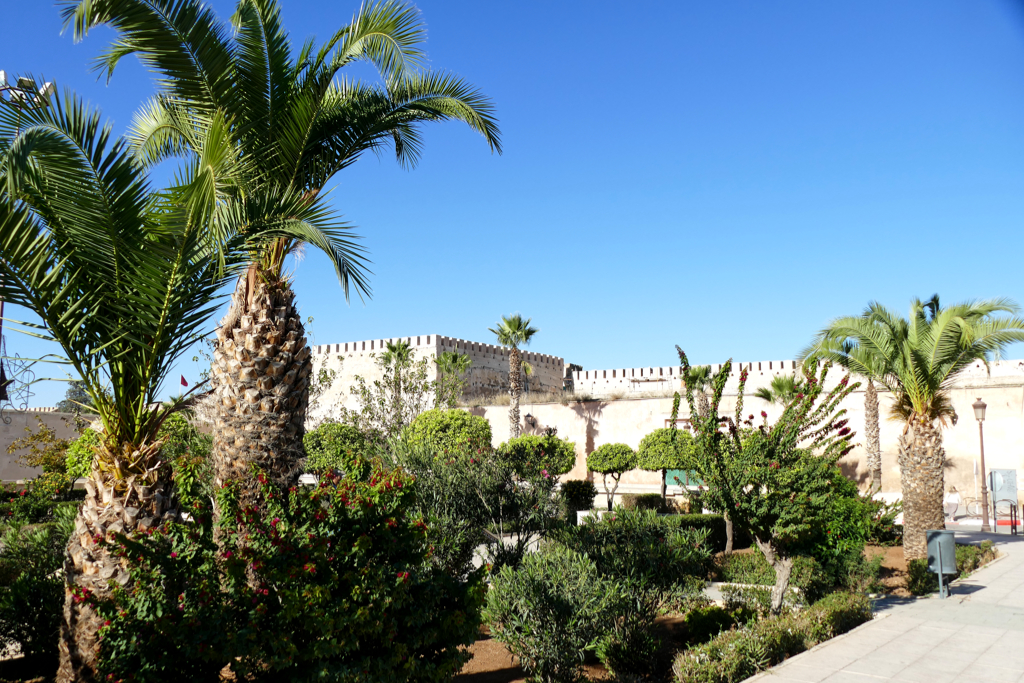
Eventually, the Islamic Berber dynasty of the Merinids ruled Morocco and other parts of the Maghreb from the first half of the 13th until the second half of the 15th century. After their rule, Meknes fell into disrepair for more than 250 years.

In the 17th century, the Alawid sultan Moulay Ismail made it the capital of his empire and redesigned it drastically. To the east of the old town, he had a new residential city built, the so-called Ville Impériale. This made him kind of the Sun King and consequently, his crib a Moroccan Versailles.
Together with the Medina, UNESCO put Meknes’ imperial city on the World Heritage List in 1996.
Nothing lasts forever, hence, after Moulay Ismail’s death, the country’s capital was moved back to Fez.
10 Must-Sees in Meknes And Two Day Trips
Place Al Hedim
The Place Al Hedim is the central square of Meknes. It is located right in front of the Bab Al Mansour, the most famous gate in all of Morocco. Just like its big sister in Marrakech, it is the gathering spot for merchants and storytellers.
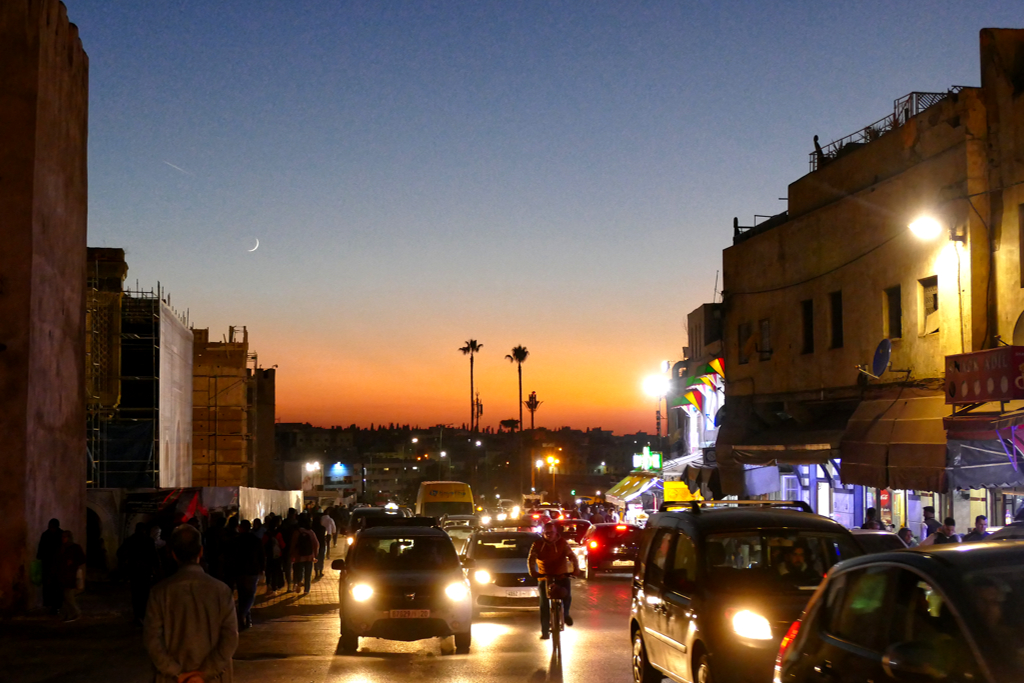
In the evening, Place Al Hedim, turns into a large open-air restaurant.
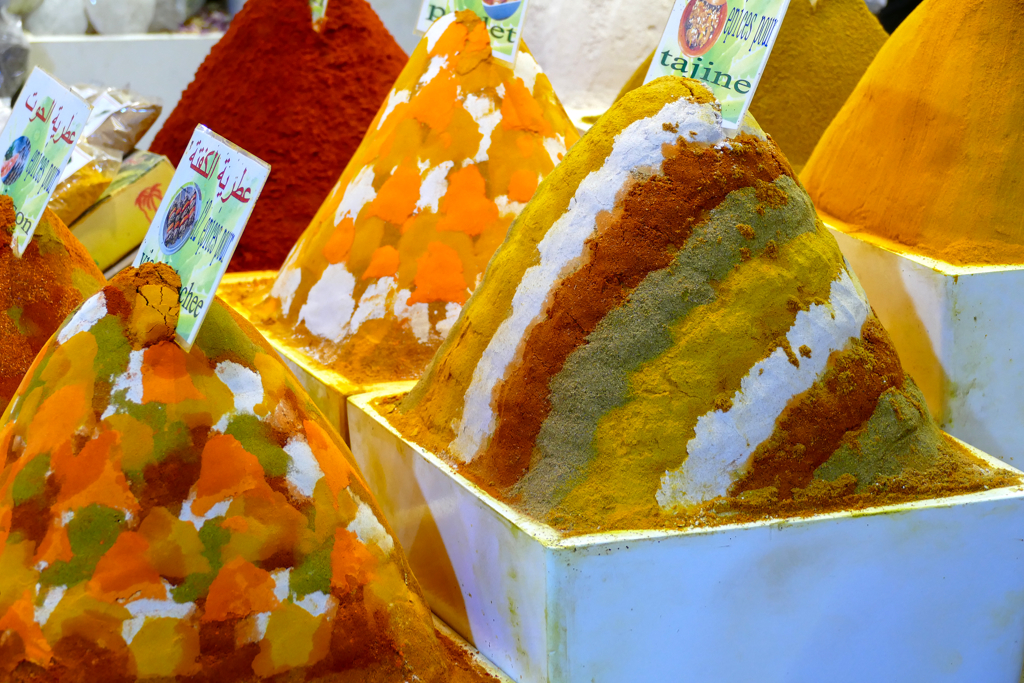
On the south-west side of the square is the covered market of Meknes. And as I’m there, it is covered, indeed, because – by now, you probably guessed so, construction work is going on. Nevertheless, the market hall remains open so that I can enjoy the variety of sounds, smells, and sights.
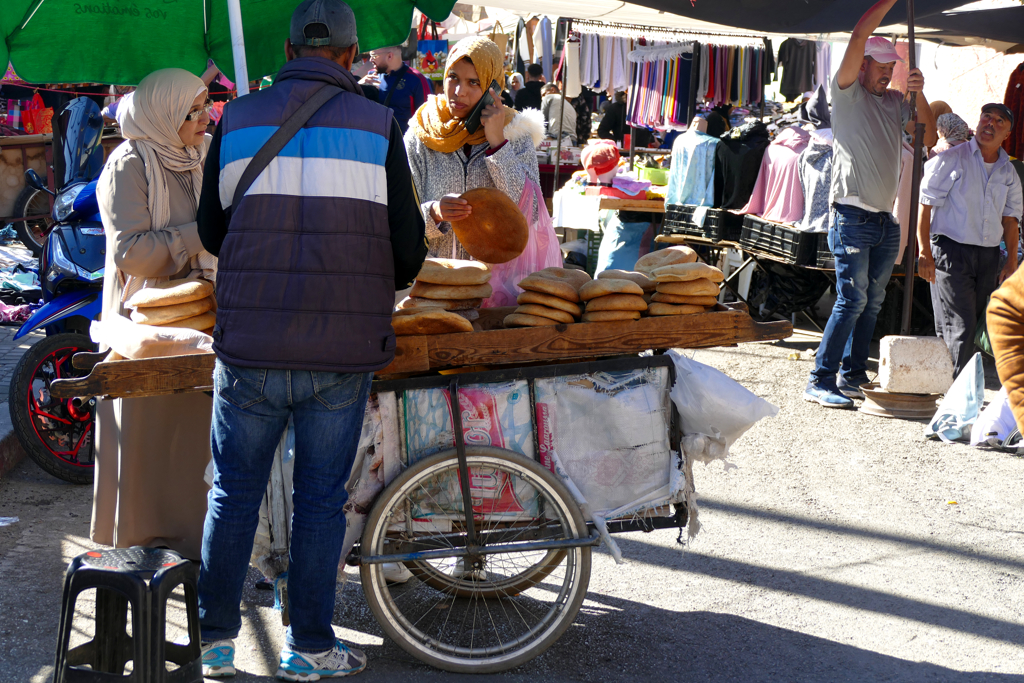
After I was first a bit disappointed by the lack of shops selling local souvenirs, I quickly got to appreciate the real Moroccan markets with the merchandise spread out on the ground or on small carts under holey umbrellas. Obviously, I wasn’t interested in buying counterfeit Adidas sneakers or yummy sheep heads. But I got an unadulterated impression of what everyday life in Morocco really looks like.
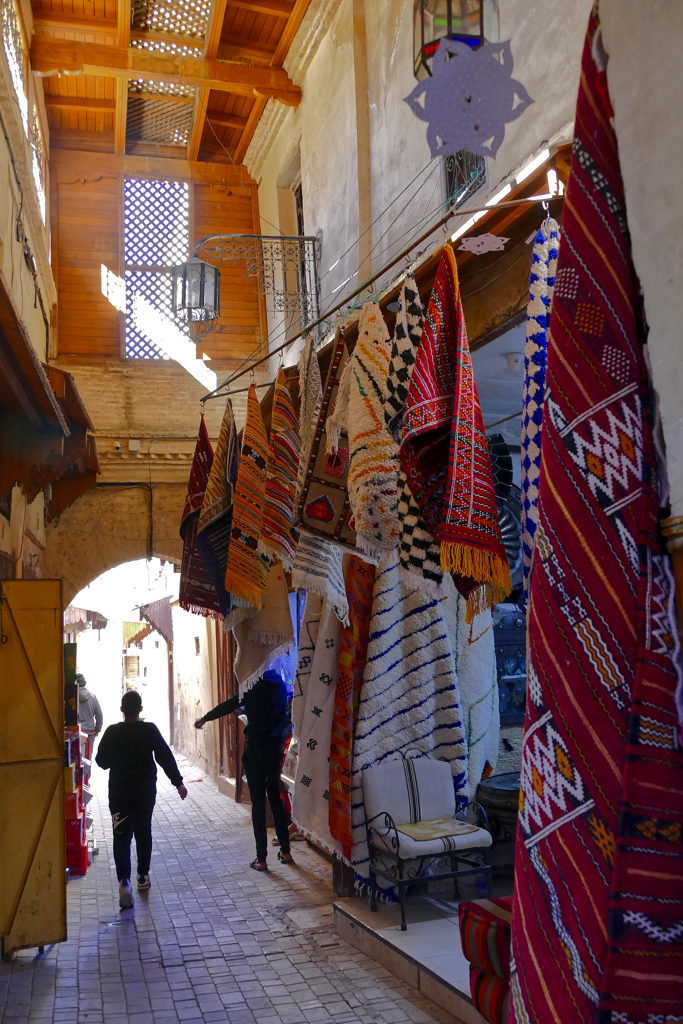
Meknes’ Medina is located on the western side of the square. Actually, this is the slightly more touristy part of Meknes, where you also find some souvenir shops, however, you cannot compare them to the businesses in Fez or Marrakech. If you’re in the mood for shopping, do it in either one of those cities as the choice is much wider.
Bab Mansour
After the transfer of Morocco’s capital from Fez to Meknes, Moulay Ismail commissioned many glorious constructions, including the Bab Mansour in the early 18th century. However, it was accomplished after his death in 1727 by his son and temporary successor Moulay Abdullah. Assumably, its architect was a Christian prisoner who converted to Islam.
Today, the particularly magnificent Bab Mansour, which roughly translates to Victory Gate in Arabic, is one of the most important sights not only of the city of Meknes, but of all of Morocco.
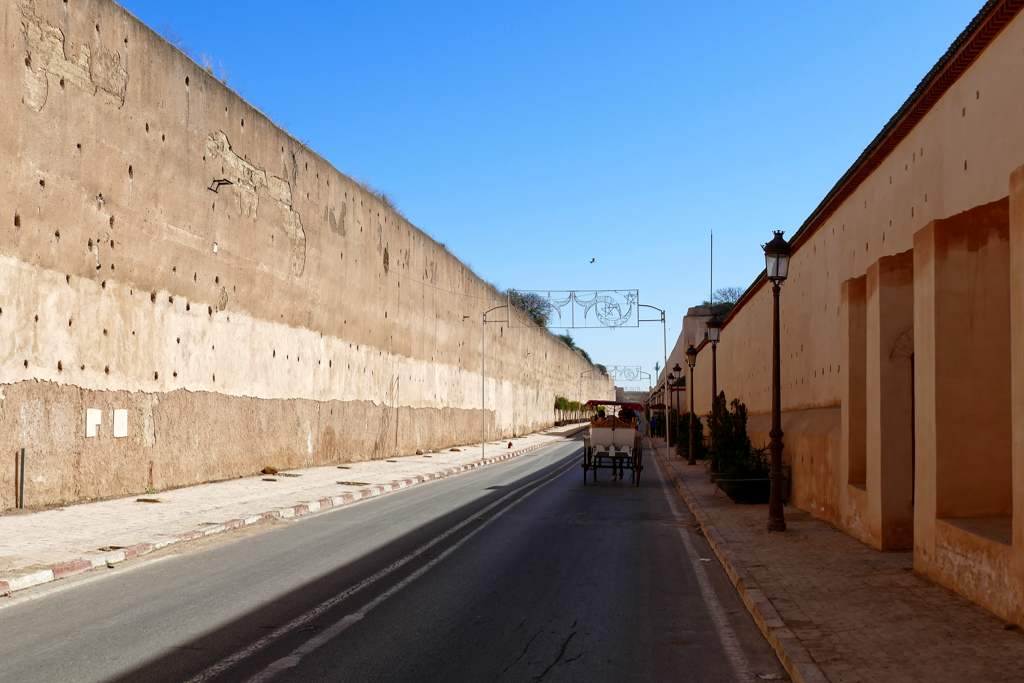
It is located on the border between the medieval Medina and the vast fortified Kasbah, the palace grounds. Since the early 18th century, this terrain is surrounded by a separate earth wall.

Just about 50 m south of Bab Mansour stands the Bab Jemaa en Nouar. Although considerably smaller, it is also lavishly decorated.
And the best thing about this Bab is that behind all the scaffolding, at least its upper part is still visible
Place Lalla Aouda
I had spent the weekend before in Marrakech where I experienced the craziness of the world-famous Jemaa Al Fna every day. Therefore, Meknes’ Place Al Hedim couldn’t impress me much. It looks just like a sad copy.
What I liked, however, was Place Lalla Aouda on the grounds of the former imperial city right behind the imposing city wall. The entrance from the main road is between the Meknes City Museum and the Bab Mansour.

Since there is just one small kiosk in the square and no charmers whatsoever, it has a very serene atmosphere to it. There are benches and playgrounds for kids, so it’s a very popular place with local families.
Close to the entrance gate, however, tourists can hire one of Meknes’ famous carriages that will take you around the endless walls of the former imperial city.
Mausoleum Moulay Ismail
No, I did not get to see the celebrated Bab Mansour, yet, I had the opportunity to step through the beautifully adorned Bab Moulay Ismail.
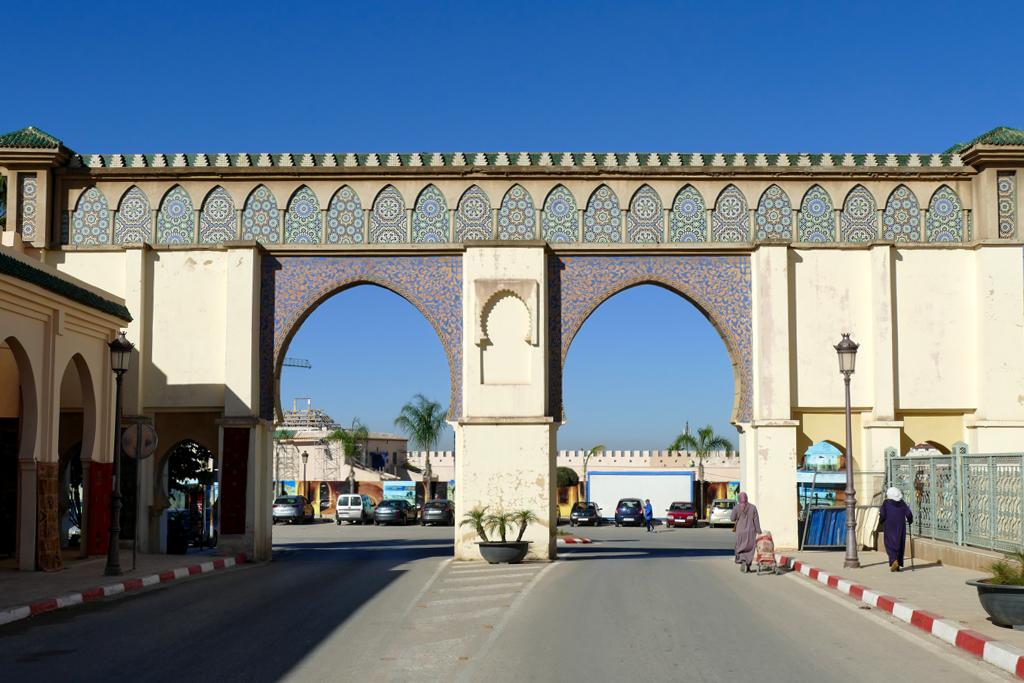
It is one of Meknes’ city gates and dates back to the 17th century. Obviously, it was named after Moulay Ismail, the man who made Meknes great.
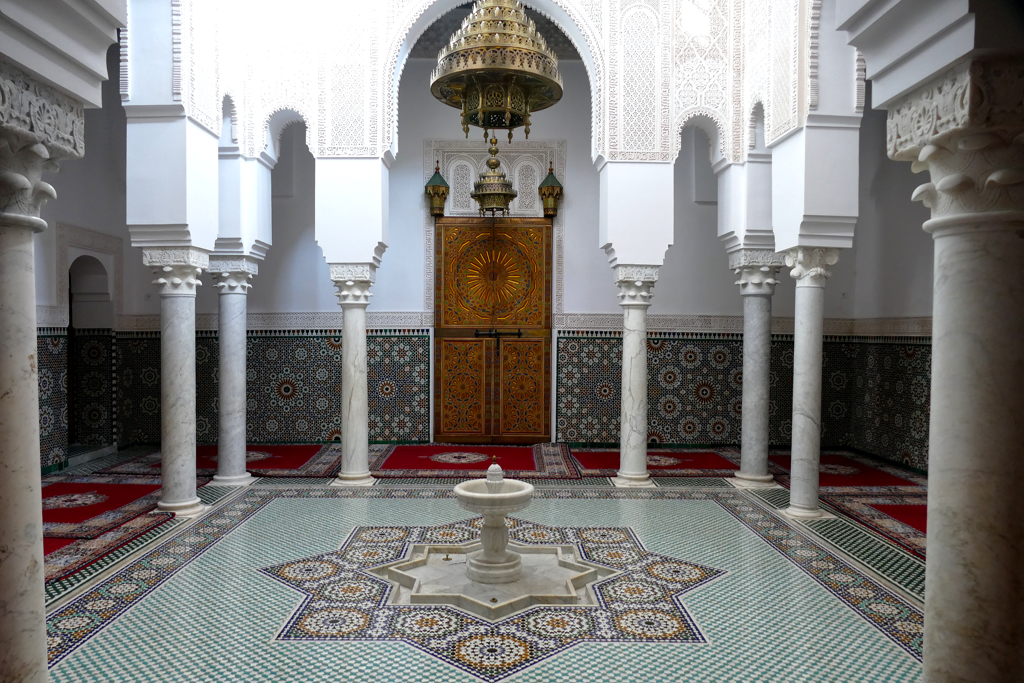
To no surprise, the final resting place of this great man is right next to the gate. Actually, the Mausoleum of Moulay Ismail is a funerary mosque.
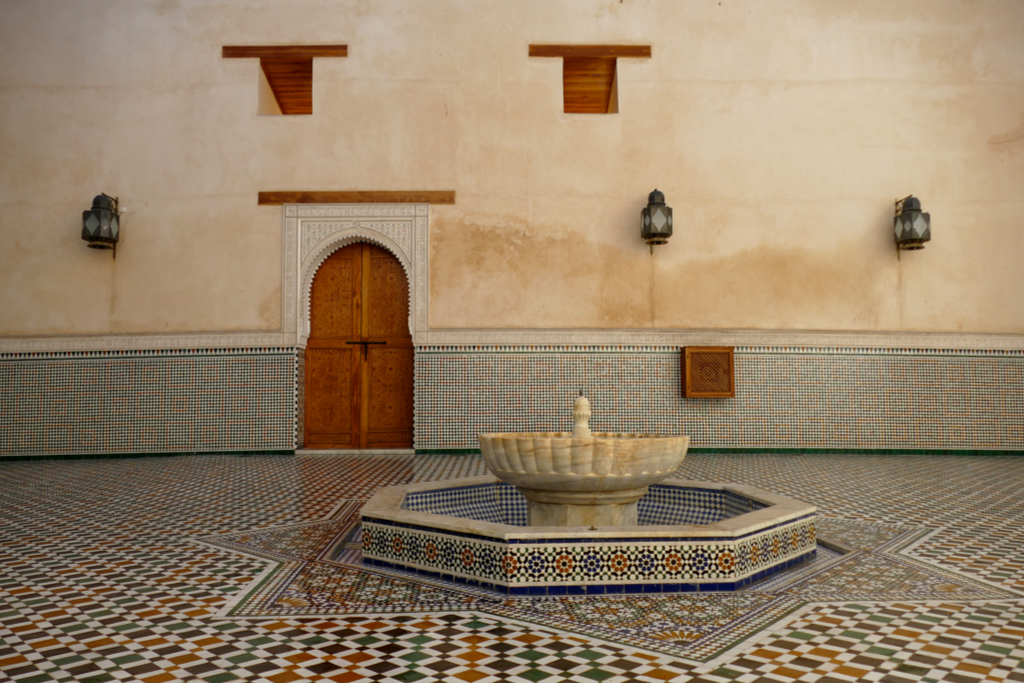
I was delighted that even non-muslim tourists can enter major parts of the building. The mosque was designed by Moroccan architect Ahmed Eddahbi and completed in 1703.
Dar Al Makhzen
Dar al-Makhzen is used metonymically for Morocco’s political power as well as the royal palaces in Fez, Marrakech, Rabat, Tangier, and, obviously, Meknes.
Initially, the Marinid Sultan Abu Yusuf Yaqub commissioned a first Kasbah, hence, a fortress, respectively fortified quarter of Meknes in 1276. Actually, this was the same year the fortress in Fez Al Jadid was constructed to be the capital of the Marinid empire.
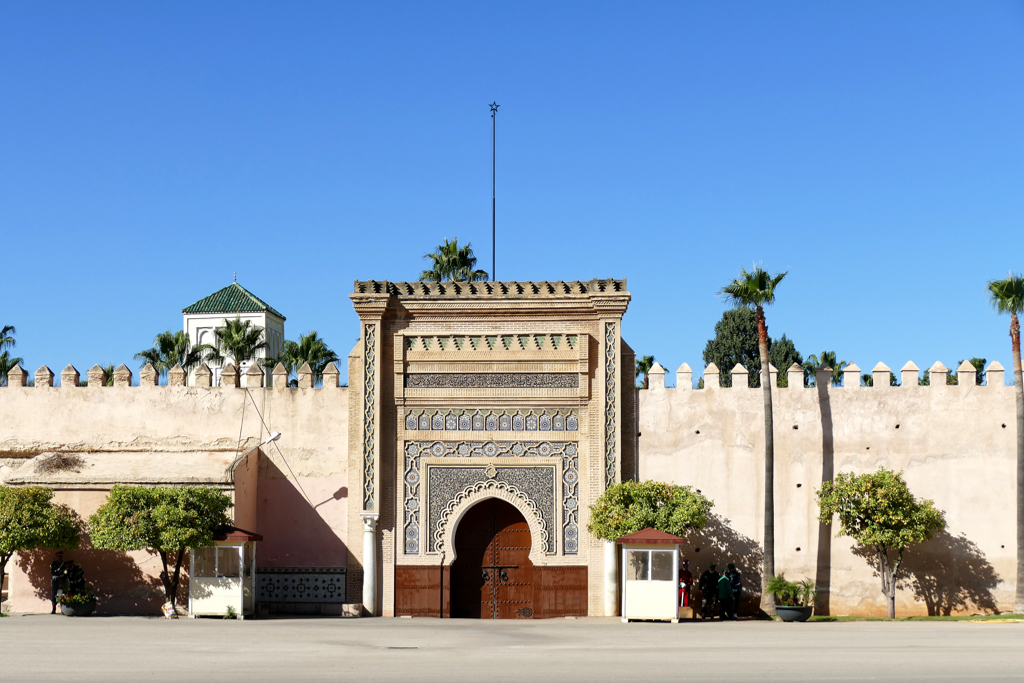
Eventually, Moulay Ismail commissioned a vast palace complex and royal Kasbah on those grounds. It took decades to build. As a matter of fact, the Kasbah was much larger than the city of Meknes itself. For obvious reasons, historians later nicknamed it the Versailles of Morocco.
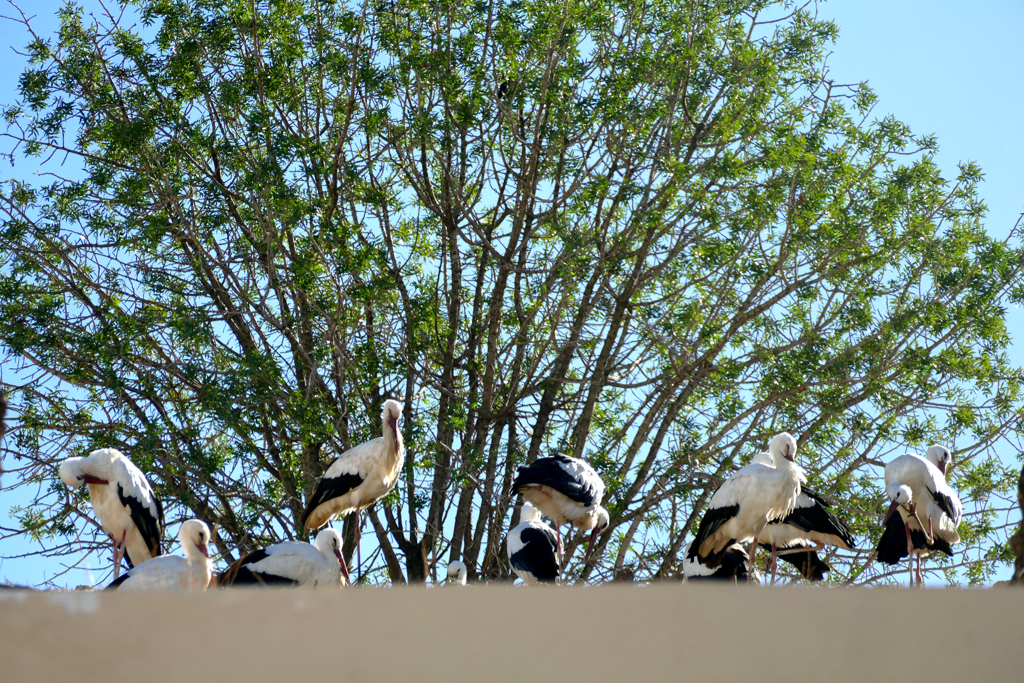
After the end of the Marinid period, however, the Saadian dynasty that ruled Morocco in the 16th and 17th centuries took care of their capital, which was Marrakech, and consequently neglected Meknes.

Today, many of the original buildings are in ruins or have completely vanished. However, some of the monumental structures remained. Actually, the Dar Al Makhzen is still in use. It serves the Moroccan King as one of his residences.
Heri As Souani
In the Dar Al Makhzen’s vicinity is a large complex of structures that used to serve as a storehouse. Spacious stables and a large water basin are also found on the edge of the so-called Ville Impériale.
Unfortunately, the Heri As Souani, as well as the adjacent Basin Souani, are undergoing renovation and cannot be visited. Nevertheless, just walking around the building gave me an idea of its magnitude.
Basin Souani
Having seen the basin completely empty was probably the biggest disappointment of my visit to Meknes. From the pictures I’d seen, it must be a fabulous sight, so I think I need to come back as soon as they fill this otherwise sad sinkhole with water.
In fact, Moulay Ismail had this basin built to ensure the water supply not only to the palaces and mosques, but also to the public baths, houses, and orchards in the event of a siege or during droughts. The basin is 320 meters long and almost 150 meters wide and has a depth of 3.20 meters.
Borj Bel Kari
Walking back from all those inaccessible glories, I passed Borj Bel Kari, a defense tower built in the 17th century as a part of Kasbah’s defensive walls.

Since 2004, the imposing tower has housed a pottery museum.
The museum is open to visitors from Wednesday to Monday from 9 a.m. to 4 p.m. for an admission fee of 10 Dirhams.
Museum Dar Jamai
Mokhtar ben Arbi Al Jamai, the vizier, hence consultant, to the then Sultan Moulay Al Hassan I, commissioned the Dar Jamai in 1882. After Moulay Hassan’s death in 1894, the family fell out of favour and saw much of their assets, including the palace, expropriated and given to the Glaoui family.
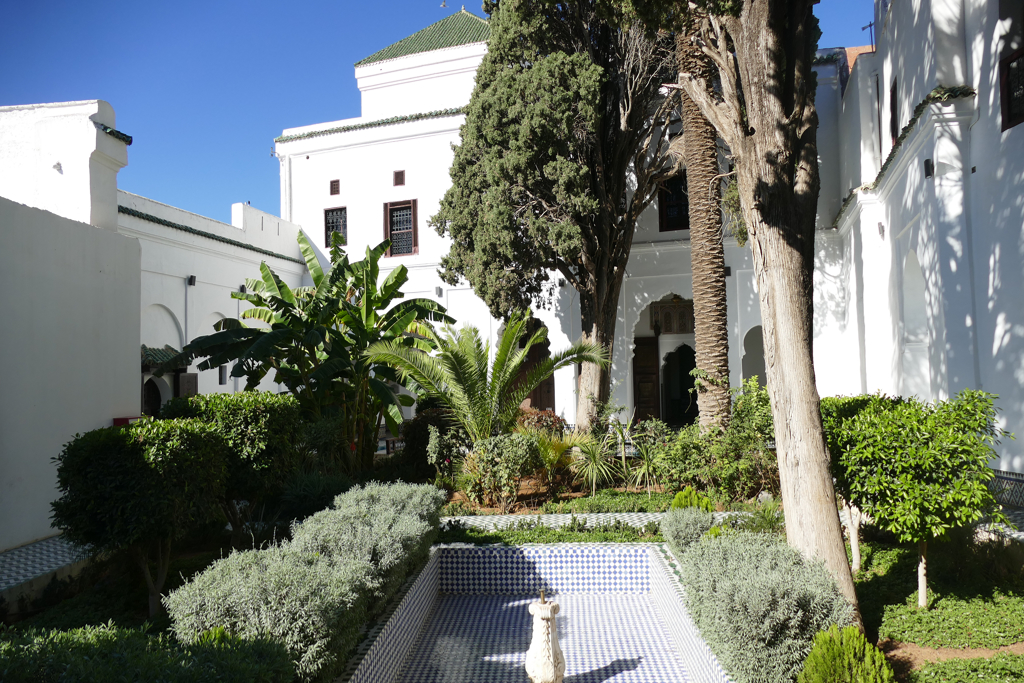
In 1912, at the beginning of French colonial rule over Morocco, the French turned it first into a military hospital, later into a military court, and finally into a museum in 1920.
Like many magnificent buildings in Morocco, the Dar Jamai is very humble on the outside. In fact, if you’re not specifically looking for the entrance at the Place Al Hedim, you might overlook it.
Inside its walls, however, the palace is glorious. It’s a two-storey building constructed around a lush courtyard. The architecture shows a harmonious combination of various lavishly decorated materials like tiles, stucco, and cedar wood.

Today, it houses a vast exhibition of different Moroccan instruments in their cultural context. This way, you also get to see some small furniture, carpets, attires, jewelry, embroidery, ceramics, and copper and brass appliances.
The museum is open from Wednesday to Monday from 10 a.m. to 5.30 p.m. for an admission fee of 30 Dirhams.
Bou Inania Madrasa
And yet again I was standing before closed doors as I wanted to be Meknes’ famous Medersa Bou Inania a visit. After all, it is one of the most artistically important historical Koran schools in all of Morocco.
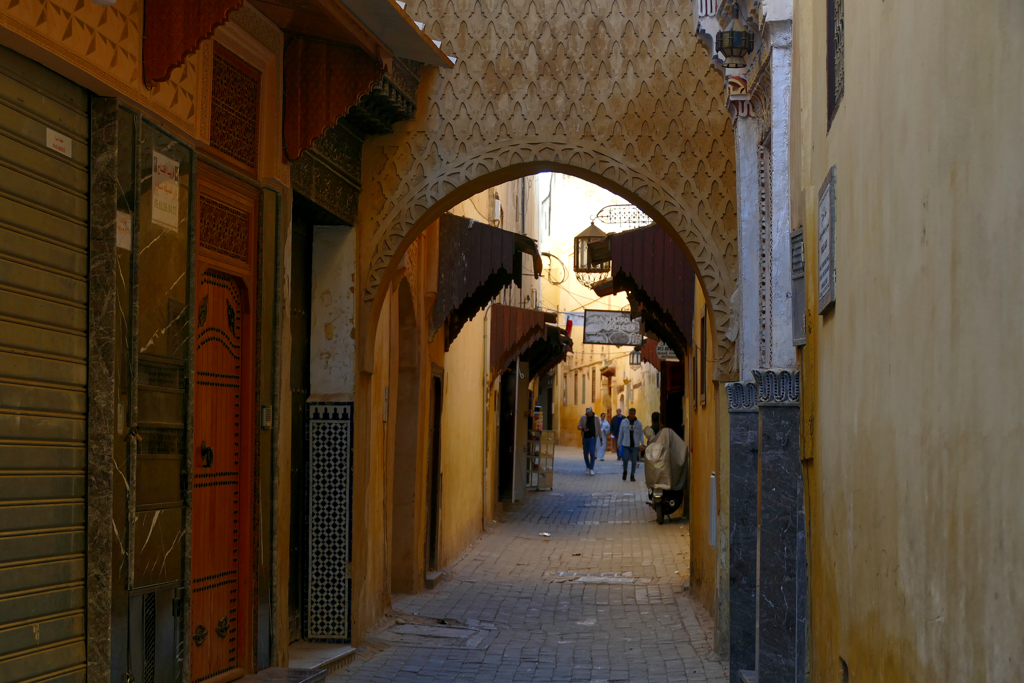
The Merinid sultan Abu Al Hasan commissioned the Madrasa. It was then completed under his son Abu Inan Faris and therefore bears his name.
It was restored during the French colonial rule over Morocco, then again in the 1990s, and was then under reconstruction until 2023.
Volubilis And Moulay Idriss
Apart from the beautiful sites and landmarks in the city itself, there are two places in Meknes’ vicinity that are supposedly worth a visit. Unfortunately, I needed to be back in Rabat quite early since I had a very early flight the next morning. Therefore, I missed out on a trip to Volubilis, a partly excavated Berber-Roman city, and the nearby highly important religious complex of Moulay Idriss.
Volubilis was constructed in a fertile agrarian area and developed over the centuries into the capital of the Kingdom of Mauretania. Under Roman rule, it grew rapidly. Gaining great prosperity mainly from olive plantations, magnificent public edifices like a basilica, a temple, and a triumphal arch as well as exquisite town-houses with large mosaic floors were built.
The two sites are only about five kilometers apart. You can get to Volubilis from Meknes either by public bus or shared cab.
If you’re in a rush, you can visit Meknes, Volubilis, and Moulay Idriss on a guided day trip from Fez*:
Practical Information
How to Get There
By Plane
Meknes does not have an international airport. The closes airport to the city is the Fez–Sais Airport which is about 75 kilometers east of the city. An alternative would be the Rabat–Salé Airport which lies about 120 kilometers west.
The fastest way to get from either of those airports to Meknes would be by cab, obviously, which will set you back at least 500 Dirham from Fez and 1500 Dirham from Rabat.
The cheapest and actually very comfortable way is by public transportation.
Arriving in Fez-Sais, take either a cab for something between 120 and 150 Dirhams or bus #16 for as little as 4 Dirhams to the city’s bus respectively train station. From there you can continue to Meknes for about 30 Dirham.
From the Rabat-Salé Airport, a cab to the train station in Salé costs 50 Dirham and the train ride will set you back another 70 to 85 Dirham.
Note that trains from both destinations are going at least by the hour.
What Are Your Tips On Packing?
If you are going to Morocco, you definitely can leave your kitchen sink at home. You simply should travel light which will make your trip smoother and cheaper – at least when you are opting for one of the low-cost airlines that charge extra for basically everything.
How to pack light? That’s easy: Just read my post on Packing Light – Travelling in Style and you’ll be all set. Also, Morocco is a shoppers’ paradise. And I’m not talking exclusively about djellabas and babouches. You’ll find all kinds of international brands in the modern parts of Morocco’s cities. Hence, in the unlikely event that you’ve forgotten something really important, you’ll be certainly able to obtain it right on the spot.
Land Routes
Train
Meknes can be easily reached by train from Morocco’s larger cities. From Marrakech, it takes a bit over six hours, and tickets start at around 200 Dirhams. Casablanca is around three hours away and Rabat approximately two. Tickets to these cities start at about 80 Dirhams. From Fez, it’s only one hour for as little as 30 Dirhams.
The fares quoted are for seats in the 2nd class compartments. Fares in 1st class are about a third higher than in the 2nd which is not a lot of money given how cheap tickets are.
I took the train a couple of times. The difference between 1st and 2nd classes is the size of the seats: In 1st class, three people sit in one row and have a bit more space since, in 2nd class, it’s four. Also, 1st class is more climatized which in November was not really an advantage. In summer, however, this might make a truly dramatic difference.
During my trip, I did not experience even the slightest delay. Although the trains are not squeaky clean, they are okay. There is a guy selling refreshments, and assigned numbered seats in 1st, as well as 2nd class, are another convenience. All in all, travelling by train was very reliable and comfortable.
The young man on the train was right: If you are coming to Meknes to visit the old historic part, you should get off at the Gare Al Amir Abdul Kader. Getting from the train station to the Medina by shard cab costs 3.5 Dirhams, and an individual cab ride sets you back 10 Dirhams.
Bus
There are three bus terminals in Meknes: The Gare Routière where the cheapest buses depart. It is close to the Mellah, the former Jewish quarter, west of the old city center. Then, the bus companies Supratour and CTM are found at the bus station right next to the Meknes train station.
Especially most international travellers prefer Supratours and CTM for their reliability and cleanliness. But since those buses are much nicer and cleaner than the others, they actually cost double the fare of a standard local overland bus. Passengers usually come to the station in the morning to book their tickets for the afternoon or the next day after and collect stickers for their luggage. Hence, don’t just show up at the last minute, they might leave you behind.
Shared Cabs
Travelling by so-called Grands Taxis is very popular among Moroccans and a viable alternative to trains and buses also for visitors. Spots in the taxis are sold individually. Mind you they usually carry four passengers in the rear and two in the front. To have more space, you can purchase more than one seat. This being pointed out, I personally find it underlines the economic and social differences, but that’s a very subjective view.

A ride from Meknes to Casablanca shouldn’t cost more than 170 Dirhams per seat. Note that these fares are regulated, hence, it’s worth checking the official rates with the tourist board or another reliable source.
A Grand Taxi station is on a huge parking lot between the Medina and the former Mellah.
How to Get Around
Within the city of Meknes, taking the local Petits Taxis shouldn’t cost more than 10 to 15 Dirhams.
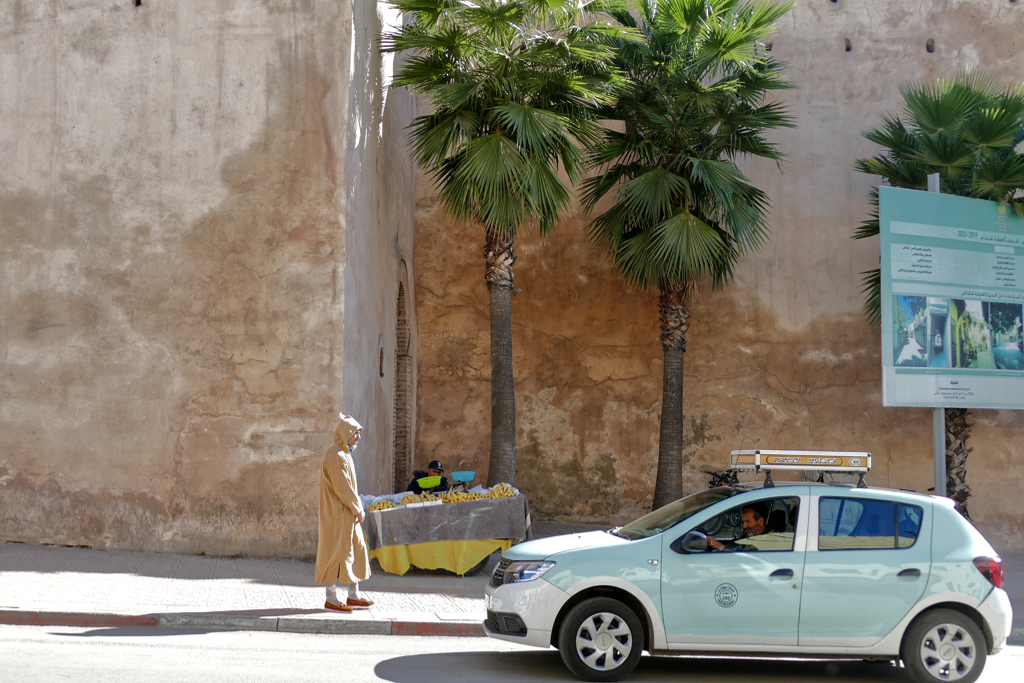
Major parts of the Medina are pedestrian zone which is by far not as chaotic as the Medinas in Fez and even in Marrakech.
How Safe is the City of Meknes?
I would argue that visitors to Meknes tend to encounter rather annoying than dangerous forms of “crime”.
You’re rather prone to be charmed into being guided and misguided. Self-proclaimed guides will try to take you places, cab drivers will try to take advantage of you, shop owners will sell you merchandise of questionable quality at a ridiculous price, and restaurants will show you menus with prices designed especially for tourists. Many people will try to milk that foreign cow. Hence, it mostly depends on your instincts, your guts, and your brains.
You should take standard precautions regarding your valuables, especially in crowded places like Place Al Hedim and the souks in the Medina. Take as little cash as possible with you and only one credit card in case you need more money than expected. If you don’t need your passport, leave it at your accommodation. I even re-activated my old phone that I equipped with a Moroccan SIM card and used my actual smartphone only at the Riad.
Unfortunately, it can be very hard to differentiate between genuine friendliness and hospitality and professional scams. Also, sometimes there is just an extremely thin line. I was very friendly to everyone, however, I kept my distance and made it unmistakably clear when I wasn’t interested in goods or services.
Finally, I’d like to point out that I attracted far more attention as a solo-travelling woman in Meknes than in any other of the cities I visited.
Organized Trips
While I would definitely recommend joining a tour in the company of a knowledgeable and trustworthy guide on your first day in Fez or in Marrakech, Meknes is much easier to visit.
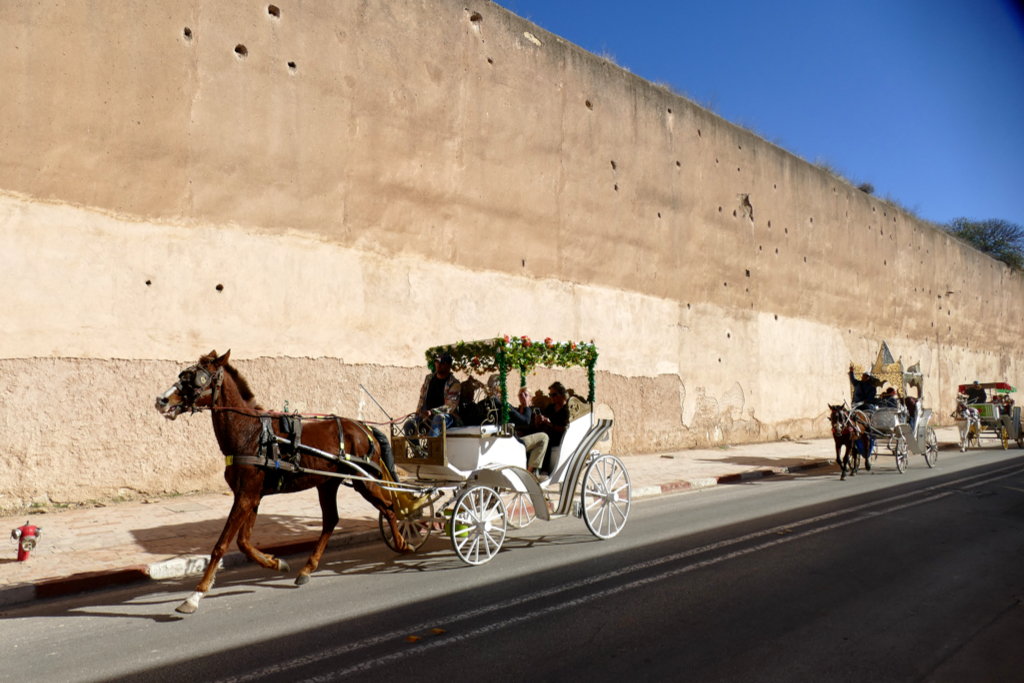
It can easily be visited self-guided. All you need is this guide. Then, you can explore the city either walking, cycling, or with a horse and carriage.
Nevertheless, especially if you have only little time and want to pay also Volubilis and Moulay Idriss a visit, I’d highly recommend you join an organized tour. You can book these tours also from Fez as a day trip. Here are some great tours to choose from*:
Where to Stay
Yes, you can squeeze Meknes into a day trip. However, I recommend spending at least one night to really immerse yourself in the city’s oriental charm. And you should definitely spend this night at a so-called Riad rather than at a regular hotel.
Yes, Riyadh is also the capital of the Kingdom of Saudi Arabia. But more importantly, in Morocco, a Riad is a traditional house or palace with an inner courtyard. You wouldn’t expect the austere, windowless outer walls to hide lavishly decorated rooms around a courtyard. The internal space is lit and ventilated through the roofless yard. This architecture offers the inhabitants protection and privacy.
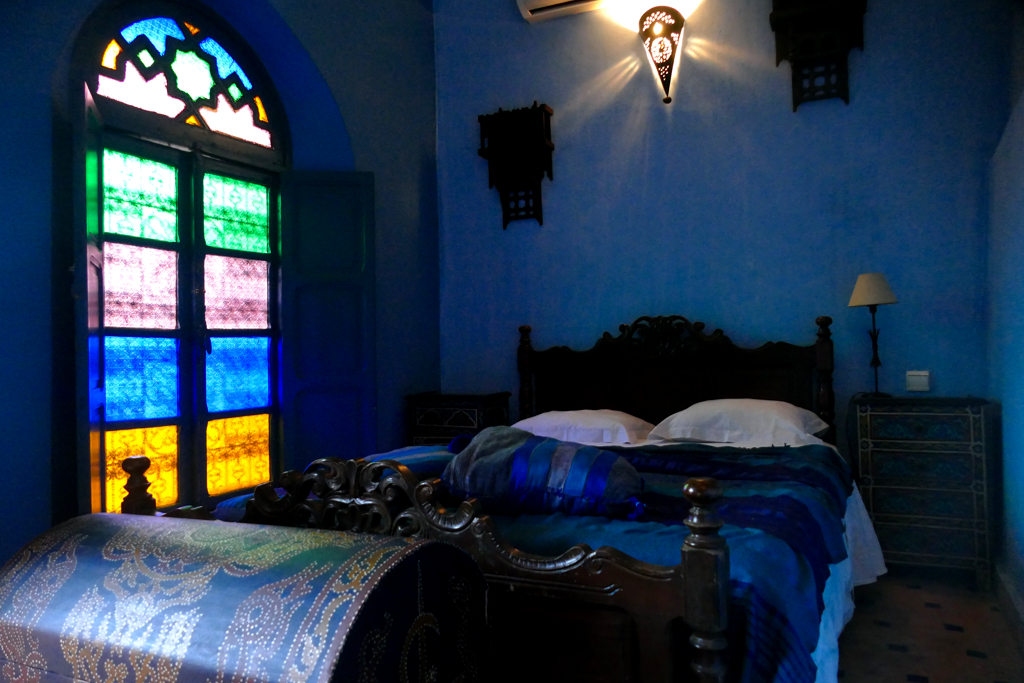
Today, many owners transform their Riads into guesthouses, conserving the original style and creating a very personal atmosphere. Staying at a Riad takes you closer to the Moroccan way of life.
I stayed at the lovely Riad Menthe et Citron* where each of the five rooms bears the name of a herbal tea. I stayed in a delightful room way up high on the roof, but since the lovely owner showed me all her guest rooms, you can pick either one and you’ll be more than fine.
However, on this map, you can check out the availability and prices of other suitable lodging options*:
What to Eat
Moroccan cooking is influenced by various cultures. Usually, it’s a mix of Arabic, Berber, Andalusian, and Mediterranean cuisines with a dash of French and Spanish food.

A big meal starts with a series of hot and cold salads, the so-called Mezze. The main course is often Tagine – whereby Tagine is the name of a clay cooking tool as well as of the dish you prepare in it. In a Tagine clay dish, couscous, potatoes, vegetables, and meat are stewed in their own juices. For the delicious oriental taste, caramelized onions, raisins, plums, almonds, boiled eggs, and pickled lemons are added.
Obviously, pork and alcoholic beverages are banned due to religious restrictions. Nevertheless, beer and wine are produced in Morocco but only enjoyed in certain bars and big international hotels. The most popular drink is mint tea.
Traditionally, Moroccans eat with their hands and use bread to get the food into their mouth.
What Are Good Eating Manners in Morocco?
No matter where you eat or drink, you should avoid using your left hand. Many Muslims actually keep their left hand under the table. This applies mainly if you eat with your hands which can easily be the case in the Medina at some of the smaller eateries. In these places, you’ll always find a sink where you should wash your hands before eating – and your greasy fingers after you’re done.
When eating with your right hand, lift the food gently to your mouth using preferably only your thumb, index finger, and middle finger. If there is bread on the table, you tear it into little pieces which you use as an edible spoon.
Howsoever, even if you eat at a restaurant, avoid using your left hand as much as you can.
When eating at a table with Moroccans, say “Bismillah” before starting to eat and “Alhamdulillah” after you’re done.
If you happen to eat at a very low table or even on the floor, make sure that the soles of your feet never point toward anyone. This is easily avoided by sitting cross-legged.
There are some truly fine restaurants in Meknes, such as the Restaurant Zitouna, just a couple of steps from the Riad Menthe et Citron*. A particularly nice option for a lovely dinner is the Palais Salma between the Place Lalla Aouda and Bab Moulay Ismaïl. On their spacious terrace, you’ll enjoy your dinner with a fantastic view over the illuminated city.
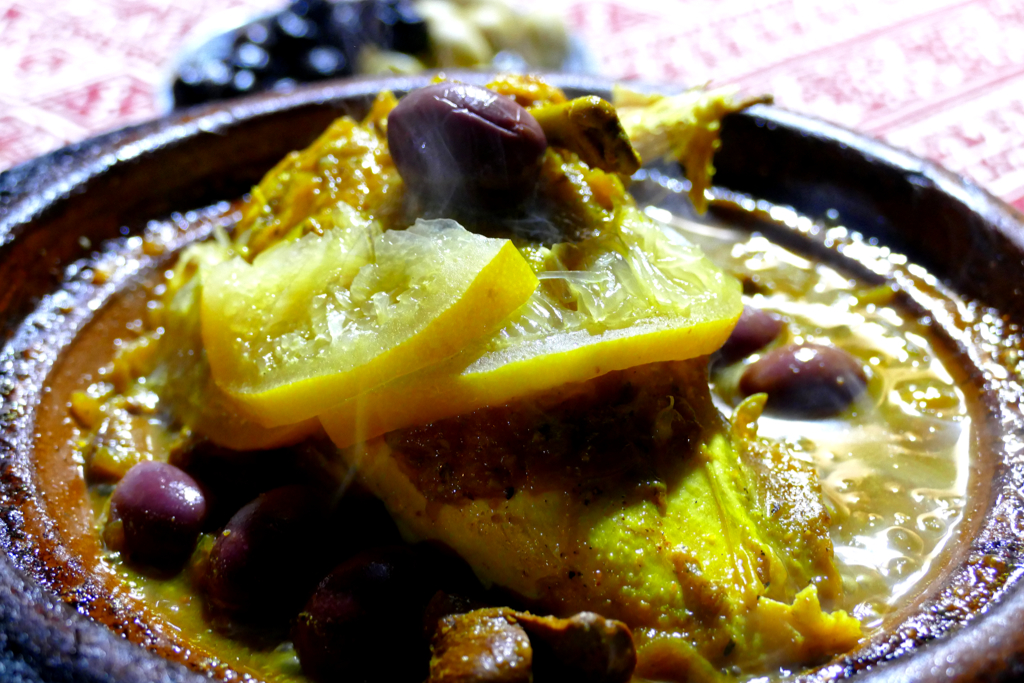
Can a Female Traveller Visit Restaurants And Bars by Herself?
As I explained above, there are many tea rooms that are frequented exclusively by men, and I assume that you will automatically stay away. On the other hand, going to restaurants by yourself should be totally fine. A reliable “gauge” is local couples and women: If they are eating and drinking there, you can sit down with confidence, too. By the way, in contrast to other countries like Spain or Greece, not once did I feel unwelcome for being a solo traveller eater.When it comes to alcoholic beverages, basically all places to grab a drink are hotel bars. You must decide for yourself how confident and comfortable you feel going there by yourself. In any case, Meknes is a much more traditional town than Rabat, Casablanca, or even Marrakesh.
Cash And Cards
The Moroccan Dirham is the country’s official currency. It is abbreviated MAD and subdivided into 100 santimat.
The exchange rate is 1 US$ = 10.70 MAD and 1 €UR = 11.10 MAD as of January 2023. However, you can check the conversion rate to US$ on this page and to €uros on this page.
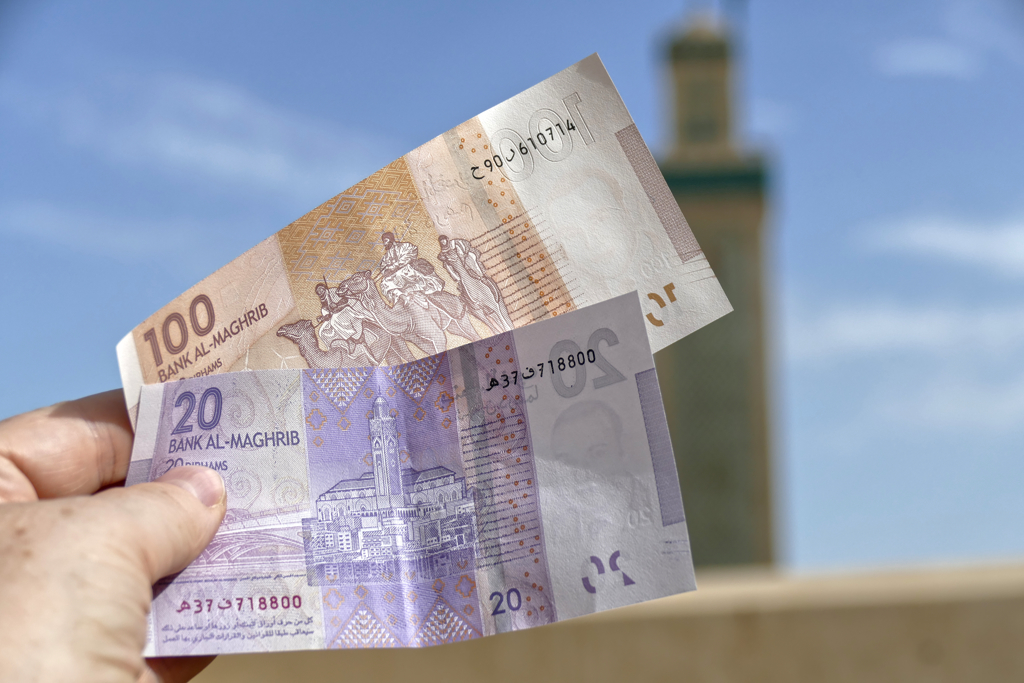
Even some small businesses and stands in the old souks accept credit cards. However, not all of them do and not everyone is happy if you pay with plastic. On the other hand, I’ve stayed in Riads where I had to pay cash for a three-night stay.
In any case, you should have cash on you. On the other hand, there are so many ATMs around that you’ll have always access to some cash if necessary.
Language
Although the two official languages are Arabic and Amazigh, most Moroccans are fluent in French since that’s the first foreign language they teach at local schools. Also, it’s Morocco’s primary language of commerce and economics, culture, and sciences.
Also, many Moroccans speak Spanish, particularly in the northern regions.
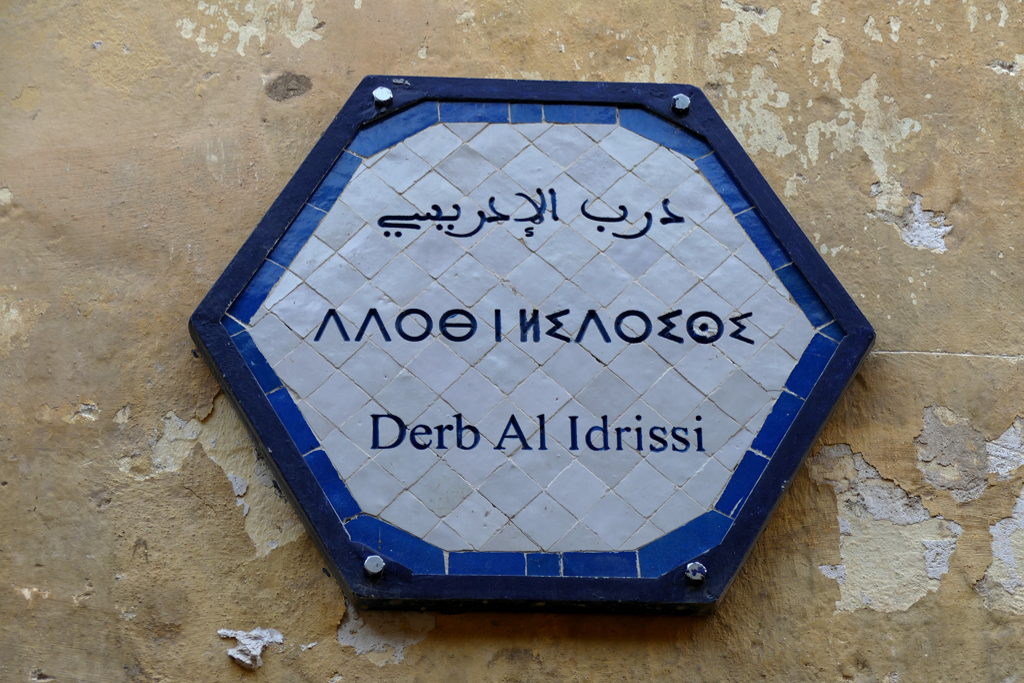
I came to Morocco to brush up on my rudimentary Arabic skills at a language school in Rabat. If you happen to speak some Arabic, too, beware that Moroccan Arabic, the so-called Darija, is very different from the standard Arabic also referred to as Modern Standard Arabic (MSA) or Al Fusha. Nevertheless, Fusha is used in books, newspapers, TV news, and political talk shows
I’ve found this really great App to broaden my Arabic vocabulary and practice what I’ve learned. It’s called Lingohut and it offers an amazing choice of more than 45 languages! Hence, if you feel more comfortable communicating in French, you’ll find it there, too.
However, due to international tourism, most people working in tourism and gastronomy speak quite decent English and very often also other languages such as Italian or German.
Connection and Communication
Since international roaming is still terribly expensive, you better get a Moroccan SIM card as soon as possible. You can get one for 20 MAD or 50 MAD from Inwi or one for 30 MAD from Maroc Telecom and Orange. They are sold either in their respective stores, at some Moroccan airports, and in many kiosks and convenience stores nationwide. Normally, you should be asked to show some ID. Nevertheless, I got mine at the train station in Salé outside of Rabat no questions asked.
Obviously, you can also use free Wifi in many places in Morocco. Basically, every mall, museum, eatery, accommodation, train station, and even the tram in Rabat offers free Wifi.
In Morocco, they use plug types C and E. Their voltage is 220 V and the frequency 50 Hz. Whereby, as nowadays all these chargers have integrated adapters, the voltage and frequency don’t really matter. By the way, you’ll find comprehensive travel info in my post World’s Most Complete Travel Information – an indispensable globetrotter-classic.
My visit to Meknes was just a small part of an amazing trip to Morocco’s Royal Cities. To read about the others, go to this post and take your pick! There, you’ll also find general information on the country and tips that will make your trip much smoother and more enjoyable.
Map
On this map, you can see where all the mesmerizing places I’m introducing in this post are located.
Clicking on the slider symbol at the top left or the full-screen icon at the top right will display the whole map including the legend.
Pinnable Pictures
If you choose to pin this post for later, please use one of these pictures:


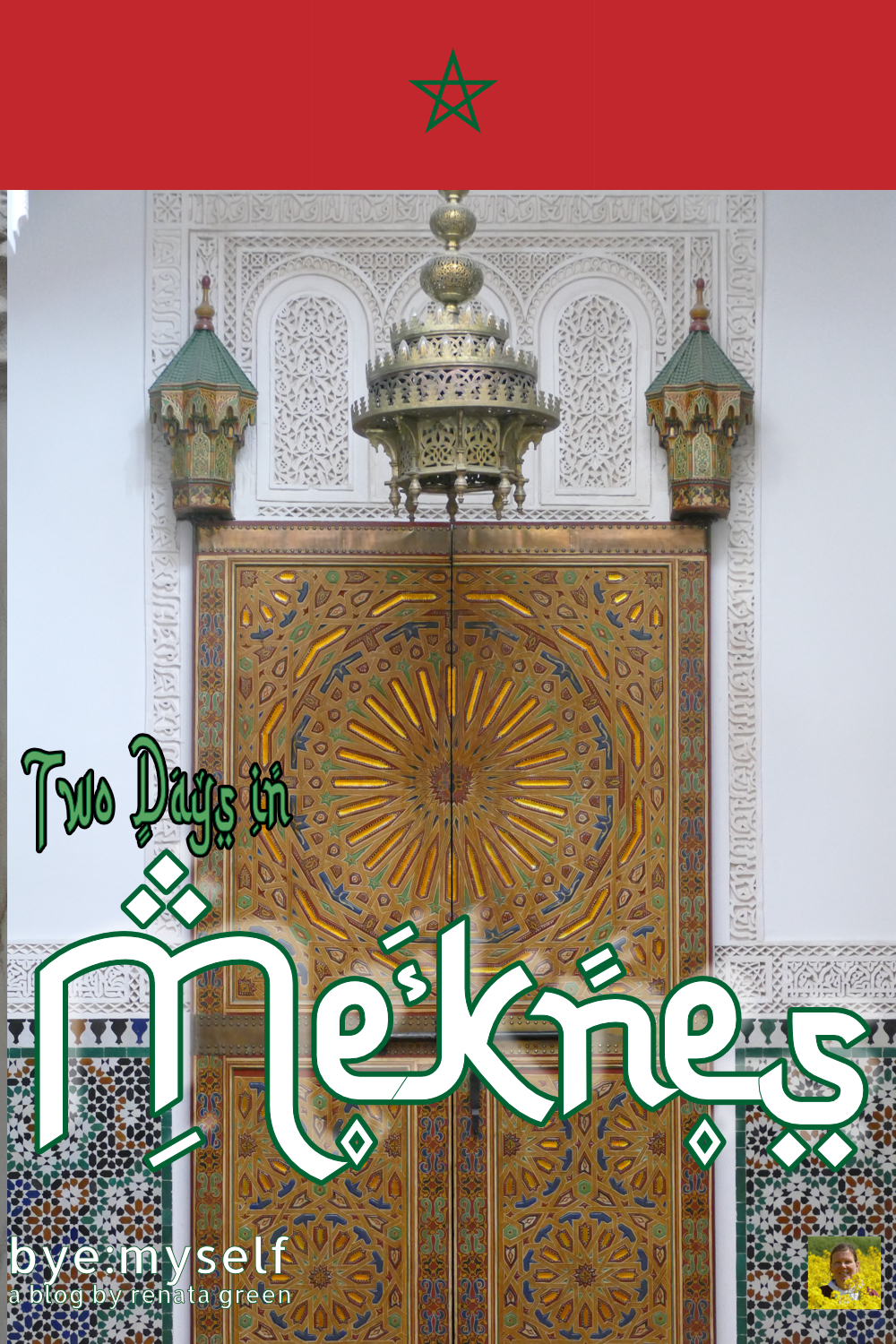
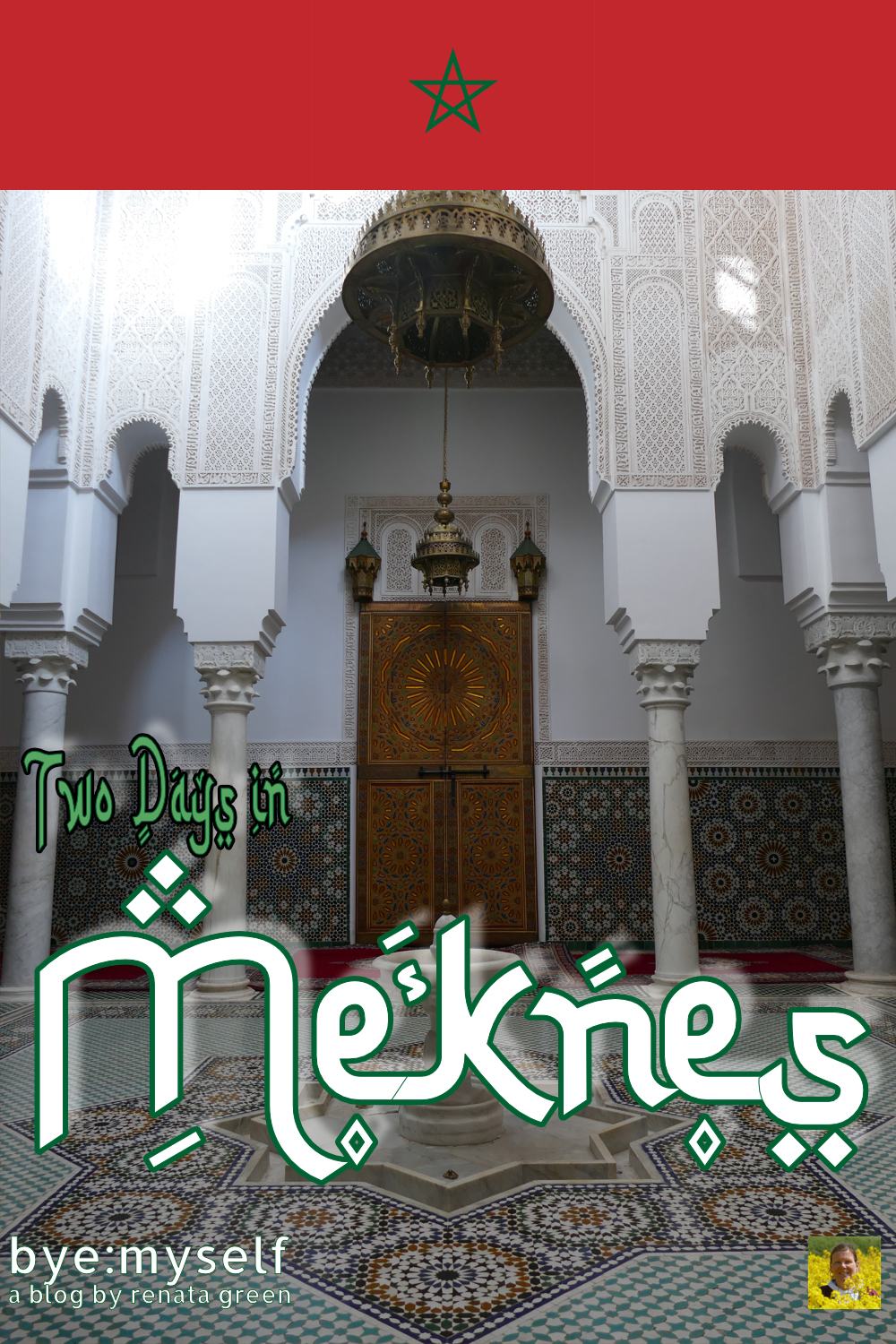
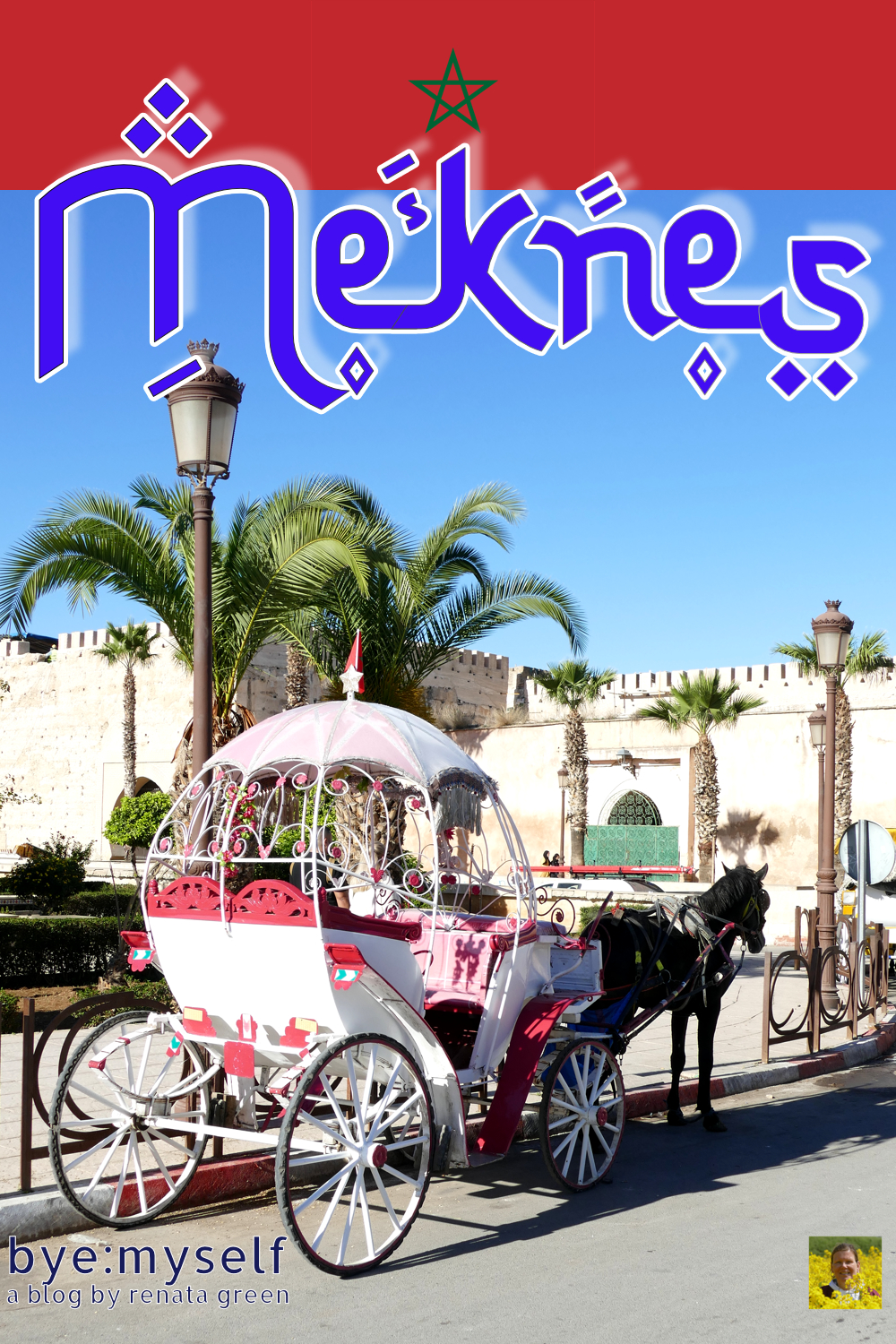
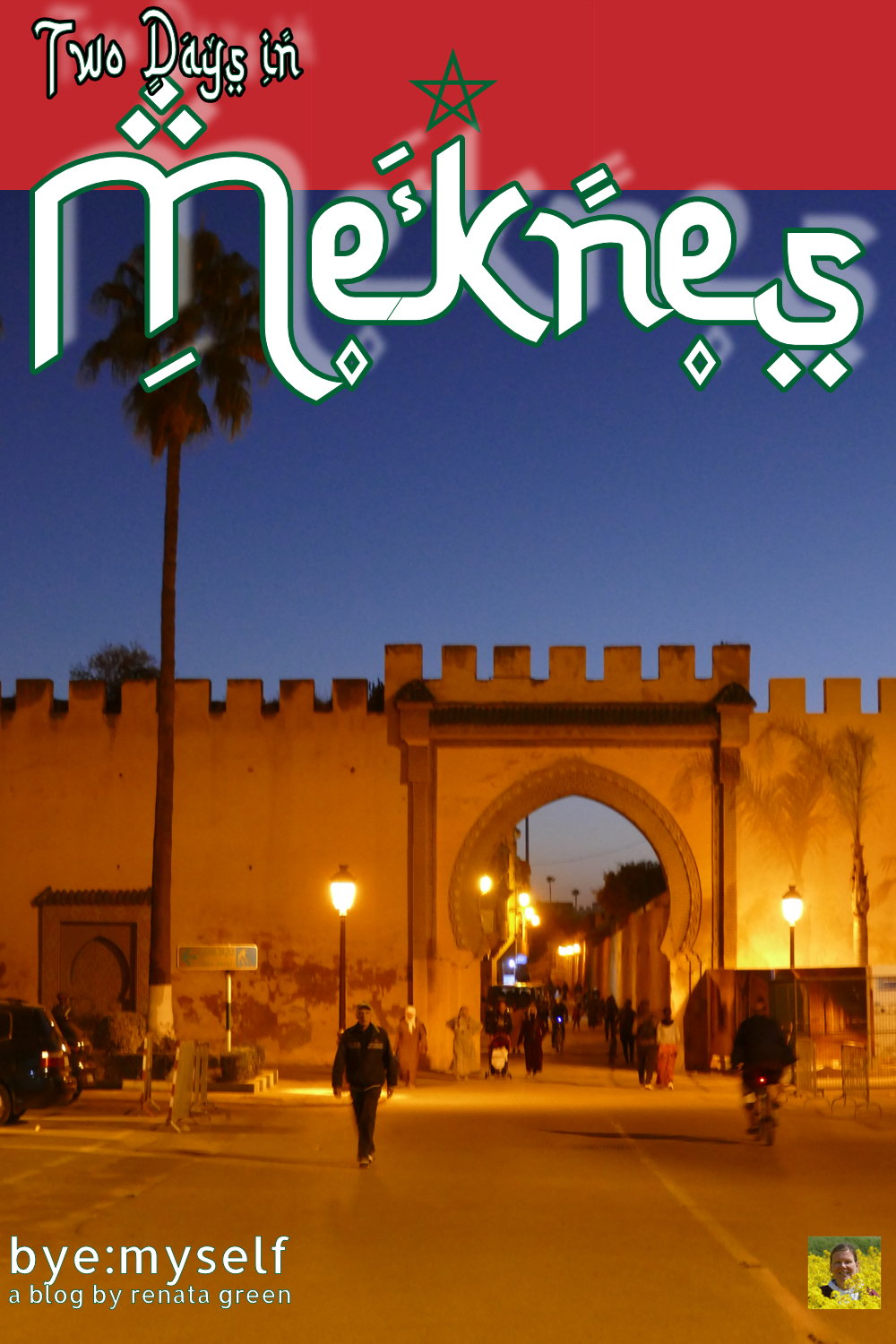
Note: This post is being regularly completed, edited, and updated – last in July 2025.
Did You Enjoy This Post? Then You Might Also Like These:
FEZ – two days in Morocco’s oldest imperial city
Two Days in MEKNES – the underrated Versailles of Morocco
Solo Female Travel to Morocco – All Your Questions Answered
RABAT – two days in the grand capital of Morocco
A Fantastical Visit to the Imperial Cities of Morocco
Three Days in Mystic MARRAKECH – How to Get Lost Without Losing It
Pickled: Easy Recipes to Store the Mediterranean Sun in Your Pantry
JIDAR Street Art Festival – How Rabat Celebrates International Urban Art
* This is an affiliate link. If you book through this page, not only do you get the best deal. I also get a small commission that helps me run this blog. Thank you so much for supporting me!
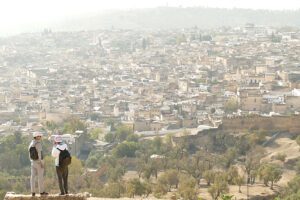



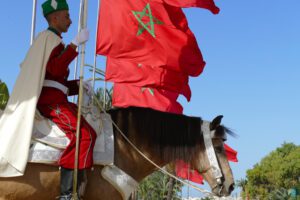
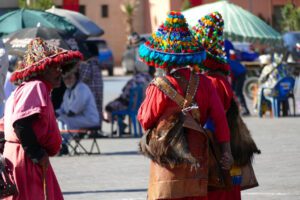


We’re a gaggle of volunteers and opening a brand
new scheme in our community. Your website provided
us with helpful information to work on. You’ve performed a formidable process and
our whole group can be thankful to you.
Thank you for reaching out – and good luck with all your endevours!
Thanks very useful information! You wrote something like Meknes was the city where you as solo female traveller gained most attention. Which city in Morocco would you say it the easiest to visit as solo female traveller?
As a matter of fact, the advances in Meknes were rather comical as they came from young boys that could have been almost my grandsons. Anyway, to answer your question, I’d say Rabat since it’s very modern. This being said, I didn’t feel unsafe anywhere – but would recommend checking out my post Solo Female Travel to Morocco – All Your Questions Answered just to avoid misunderstandings. Safe travel – enjoy Morocco, it’s a mesmerizing country!
this article is very useful, thank you for writing a good article on my home town meknes
Great read! Meknes is a blend of history and natural beauty is simply enchanting. I had an amazing time exploring it and experiencing the local traditions.
That does not surprise me since I also liked it a lot!
Wow! I learned so much about Meknes! Great photos and tons of great information, and I love reading about your personal experiences there. My itinerary for my dream trip to Morocco is expanding 🙂
Thank you for your kind words – I’m glad you like the post 🙂
Great guide to the city of Meknes. I think we spent two days in Meknes during our Morocco trip and also went to Volubilis – what was quite interesting. But then, we love visiting Roman ruins. My most vivid memories of Meknes are the storks and the beautiful gates. As for the tea shops frequented by men – I always thought they look interesting and I would love to have coffee or tea there. So at one point during our travels we decided to try it – and found out it is perfectly fine. But then, we are two women (not a single woman) and we usually try to find a table outside at the corner. But at these places usually nobody bothers us – even in places like Fez or Luxor.
Thanks for sharing your experience! As I wrote, I assumed the villagers wouldn’t chase you with torches if you order coffee in a man-only bar – and I’m sure it makes a difference if you sit discreetly in a corner. Still, I stick to the unwritten rules to avoid any kind of confrontation 😉
An excellent and comprehensive guide to Meknes. Now I know that I spent too little time in this city. But I want to return to Morocco because I was delighted with the architecture and the food so I can spend more time in Meknes. Place Al Hedim, Bab Mansour, and Mausoleum Moulay Ismail were terrific. But I was there only one day and had no time to enjoy Borj Bel Kari and Museum Dar Jamai.
Yes, I need to go back, too. Due to my early flight the next day, I didn’t have the time to see the iconic places on the outskirts – so maybe we’ll meet 😉
A Versatile type city would be great to visit. Too bad there was a lot of construction when you did. But some of the beauty shone through. My first time to hear about Meknes.
Yes, I need to come back once they are done to see it in its full glory 🙂
Sadly we only stayed a day in Meknes and roamed the palaces. I vividly remember the Cinderella type carriage you also found. For us, I think it was more of a stopping point in order to see the roman ruins of Volubilis, and then the sacred site of Moulay Idriss.
But I think when we return to Morocco, we will have to spend a day or two there because I would love to explore more of sites like the Mausoleum Moulay Ismail.
I loved seeing all the Gates & Doors you captured also because the tile work was always my favorite throughout all Morocco.
I’m also in deep love with Moroccan decor – it’s so elaborate and still not tacky. I had too little time to go to those iconic sites outside the city. But I’ll be back…. 😉
I would definitely want to visit a place labeled as the Versailles of Morocco. But I will hope that all the construction is done so I can get a better feel for Meknes. And maybe I will get to see Basin Souani filled up. The places you did get to visit looked good. And glad you got to see some places that non-Muslims could enter. Even if you could not go to all the tea rooms!
Yes, I need to go back once their digging and chiselling is done 😀